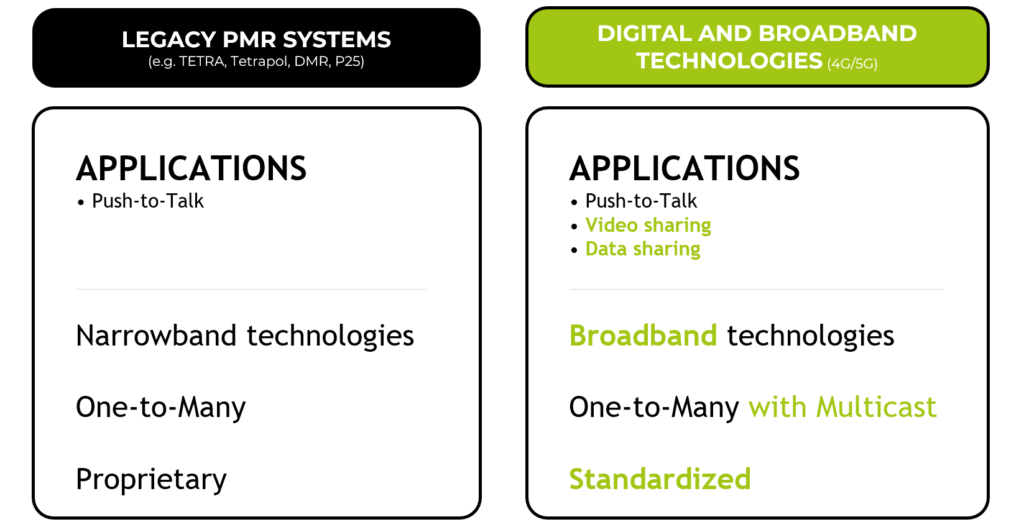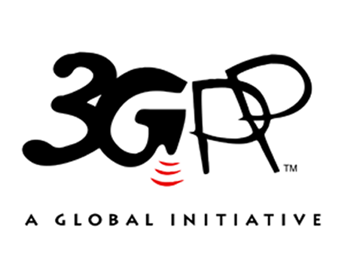Move from TETRA to efficient 4G/5G
Optimize your network bandwidth
CRITICAL COMMUNICATIONS
Transitioning from Tetra to 4G/5G Networks: Elevating Critical Communications
In the ever-evolving landscape of critical communications, the demand for seamless, high-performance networks has never been more pressing.
As industries and public safety entities navigate a digital transformation, the transition from Legacy networks (such as Tetra) to 4G/5G networks emerges as a pivotal step towards unlocking a new era of connectivity, efficiency, and reliability.
This transition is often referred to as moving from narrowband to Broadband. In terms of usage, it’s similar to moving from your old 56kbps modem to DSL.
The Imperative for Progress to unleash the 4G/5G potential:
Tetra networks, once the stalwart of mission-critical communication, have served admirably.
However, as technological advancements propel us forward, the need for networks that can accommodate larger data volumes, heightened security, and ultra-low latency becomes increasingly apparent.
The transition to 4G/5G is not just a matter of evolution; it is a strategic imperative to meet the escalating demands of today’s critical communications landscape.
Broadband vs Tetra: A new spectrum of capabilities

These advanced networks bring forth a spectrum of capabilities, from enhanced data transmission and real-time video streaming to ubiquitous connectivity and robust IoT integration.
This evolution empowers organizations with unprecedented agility, enabling faster decision-making and more effective responses in mission-critical situations.
From Proprietary to standard

Since 3GPP Release 14, completed in 2017, several types of Mission Critical applications can be provided to end-users from Mission Critical organizations or other businesses and organizations (e.g. utilities, railways) using the LTE network:
- Mission Critical Push-to-Talk (MCPTT) for push-to-talk voice
- Mission Critical Video (MCVideo) for real-time video
- Mission Critical Data (MCData) for real-time data
Broadband brings bandwidth in abundance: don’t waste it!
By switching from narrowband (Tetra) to broadband (4G/5G), you benefit from enormous bandwidth at a stroke.
But beware: unlike Tetra networks, which are natively multicast, 4G and 5G networks are unicast by default.
To take full advantage of this available bandwidth, you need to activate multicast functions on your broadband network. Know more about how to optimize your network with multicast here.
Broadband vs Tetra: at a glance
Overall, migrating from TETRA (Terrestrial Trunked Radio) to 4G/5G offers numerous advantages, making it a compelling choice for modernizing critical communication networks :
- improved data transmission,
- multimedia capabilities,
- interoperability,
- cost efficiency,
- scalability,
- security,
- support for any connected device.
Highlights
From Legacy to Broadband: Improved Data Transmission
4G/5G networks provide significantly faster data transmission rates compared to TETRA.
Beyond Push-to-Talk, 4G/5G networks enable new applications, such as Video Sharing & Data Sharing. And any other data-intensive applications that are critical for surveillance and emergency response.
Based on Broadband technologies, the communications are natively "one-to-many" by enabling Multicast.
Enhanced Multimedia Capabilities
4G/5G networks support multimedia communication, including high-definition video streaming and image sharing.
This allows for better coordination among emergency responders and facilitates real-time visual information exchange.
MCVideo
Mission Critical Video defines a service for Mission Critical video communication.
MCVideo service ensures high service availability and reliability, low latency, real-time operation capabilities, highly secure operations, inter-operability with other services and systems, private and group communications.
MCData
Mission Critical Data defines a service for Mission Critical Data services. As for all mission critical services, users affiliate to groups ro receive communications intended for them.
MCData Service provides a set of generic capabilities:
• Group Messaging
• Data Streaming
• File Distribution
• IP Connectivity
MCData Service also provides specific services such as conversation management, database enquiries, internet access, or robot control.
Interoperability with Consumer Devices
4G/5G technology is widely used in consumer devices, making it easier to integrate commercial off-the-shelf (COTS) devices into critical communication networks.
This enhances interoperability between public safety agencies and enables access to a broader range of devices and applications.
Geolocation Services
4G/5G networks offer more precise geolocation services compared to TETRA.
This enables accurate tracking of personnel, assets, and resources, improving situational awareness and response coordination during emergencies.
Cost Efficiency
Leveraging existing 4G/5G infrastructure can be more cost-effective in the long term compared to maintaining separate TETRA networks.
Consolidating communication systems onto a single network reduces operational costs and simplifies maintenance and upgrades.
Scalability and Future-Proofing
4G/5G networks provide greater scalability and flexibility to accommodate increasing communication demands and emerging technologies.
This future-proofs critical communication systems, ensuring they can adapt to evolving requirements and advancements in technology.
Enhanced Security Features
While TETRA networks offer robust security features, 4G/5G networks provide additional security enhancements such as end-to-end encryption and secure authentication protocols.
This ensures the confidentiality, integrity, and availability of critical communication data, protecting sensitive information from unauthorized access or interception.
Support for connected devices
Beyond ruggedized smartphones, 4G/5G networks support a wide range of broadband connected devices, including IoT (Internet of Things) devices, drones, and sensors.
This enables the integration of advanced technologies into critical communication systems, enhancing operational efficiency and effectiveness in emergency response scenarios.
